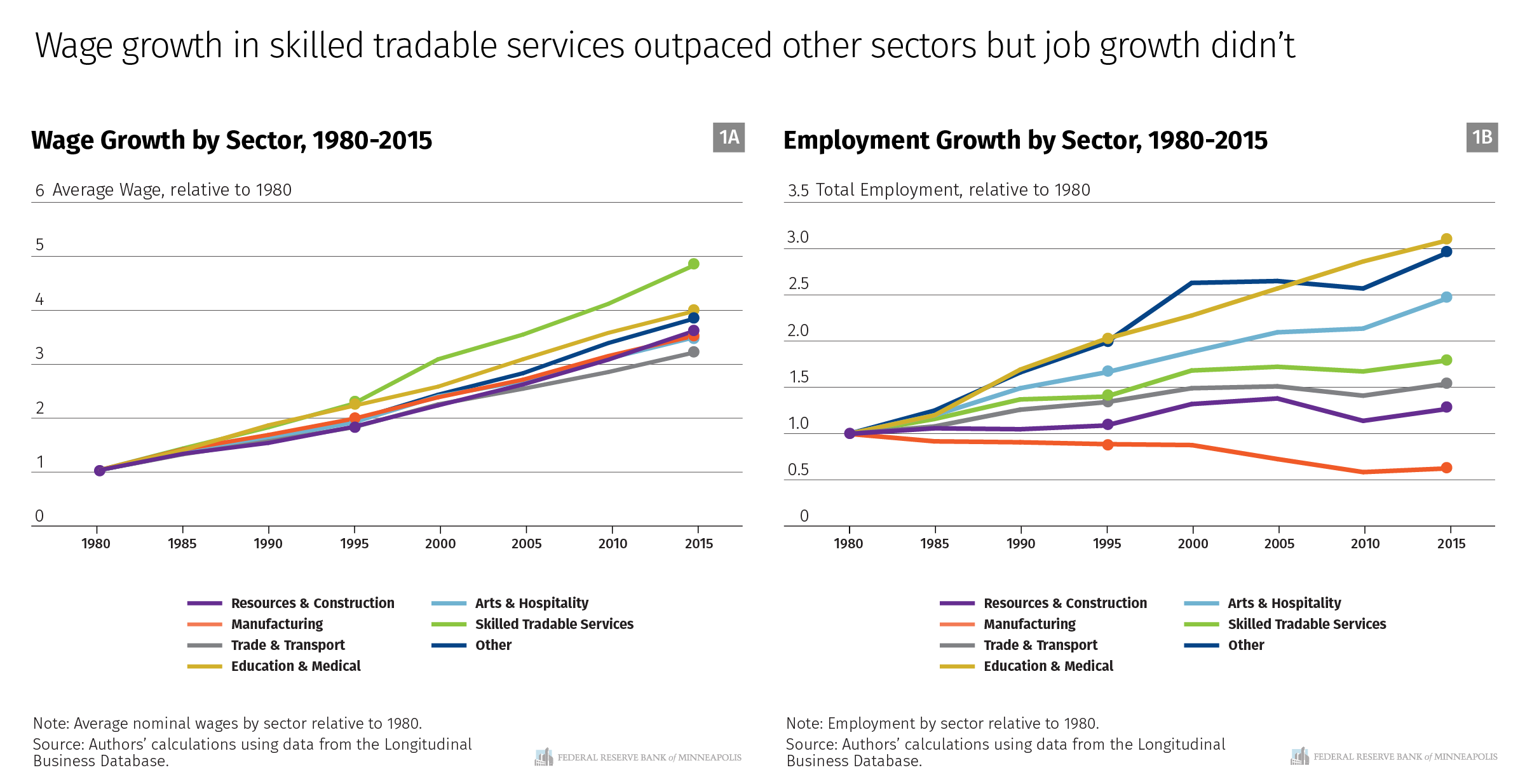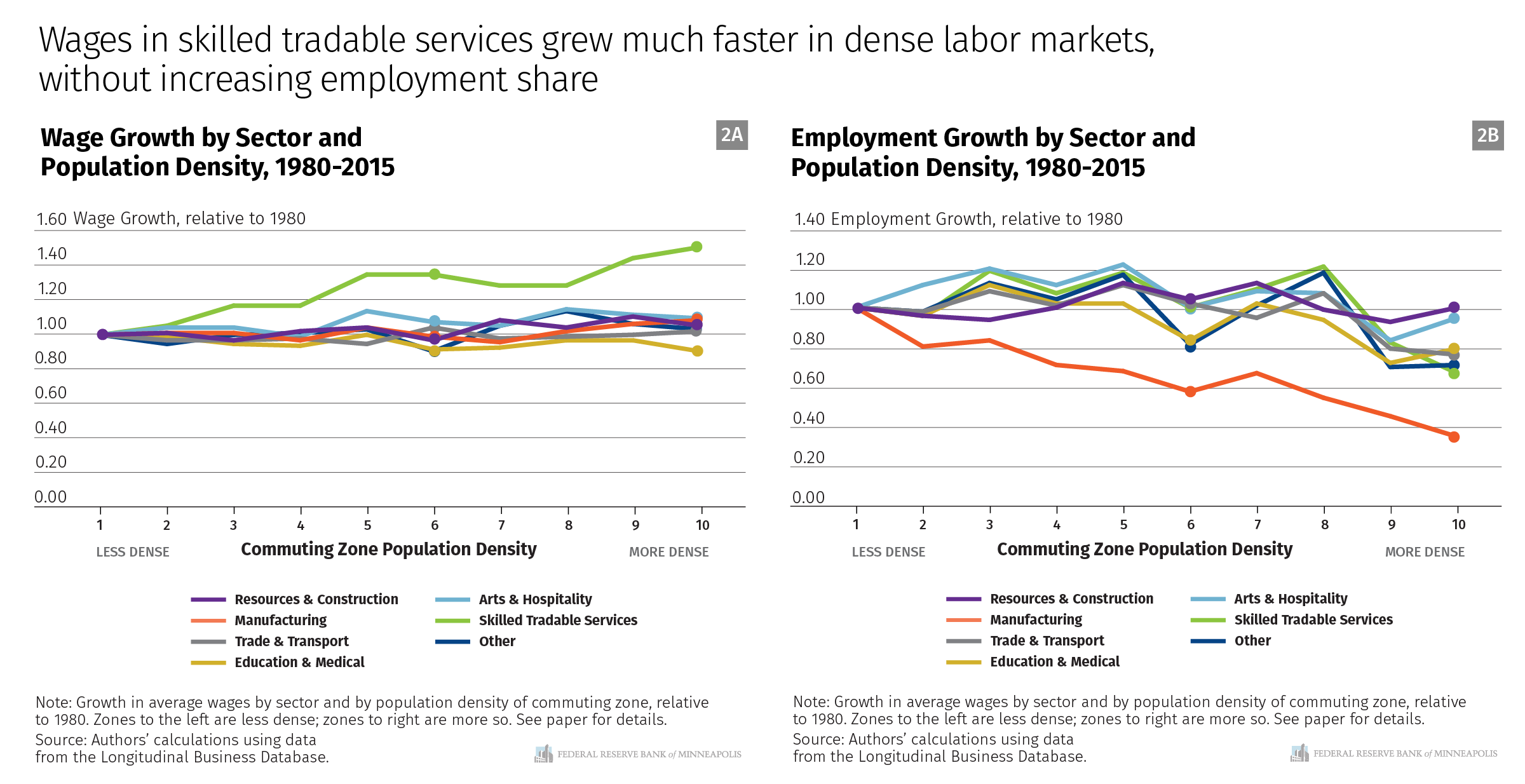The powerful rise in U.S. income and wealth inequality over the past 40 years has fractured American culture, society, and politics. Schisms are apparent geographically, too, with growing differences between urban centers and rural communities; coastal regions and the heartland. While the phenomena are frequently documented, causes are still being debated.
New research from the Opportunity & Inclusive Growth Institute (Institute Working Paper 25) suggests that “service industries that are highly skill-intensive and widely traded internationally [are] key to understanding these changes.” The researchers, Fabian Eckert, Sharat Ganapati, and Conor Walsh, refer to these as “skilled tradable services”—industries devoted to information-based functions that rely heavily on communication.
STUDY AUTHORS
Fabian Eckert is a postdoctoral associate at Princeton University and an Institute visiting scholar. His co-authors on this working paper are Sharat Ganapati of Georgetown University and Conor Walsh, a Yale Ph.D. candidate.
Skilled tradable services (STS) include management consulting, finance, information technology and services, and company management, and they have assumed an outsized importance in the country’s earnings distribution, with faster wage growth than all other sectors despite relatively slow employment growth.

Skills and stars
That highly skilled workers would earn high wages is unsurprising to economists, who are well-versed in the theory of skill-biased technological change (SBTC) as the source of rising incomes for college-educated individuals. SBTC is the idea that technological change during the 20th and 21st centuries has increased demand for educated workers, while reducing demand for those with less schooling. The rising college pay premium since the 1980s in the aggregate U.S. economy is well-documented.
But elaborating on an idea developed in an earlier paper on inequality, local labor markets, and “spatial fragmentation” of production processes, Eckert, an Institute visiting scholar, worked with Ganapati and Walsh to add another element: declining communication costs. Inspired by economist Sherwin Rosen’s landmark 1981 article, “The Economics of Superstars,” the three economists suggest that STS workers have become earnings superstars because, as Rosen showed, individuals with great talent can gain access to larger markets and incomes as communication costs drop. Competitors in that same market whose talent is just slightly less (or less popular) will lose market share to the star. Lower-skilled rivals make much less money than superstars like like Beyoncé, whose talent is shared instantly across world stages.
Alfred Marshall anticipated the idea in the 1890s, noting that the telegraph enabled leading entrepreneurs to eclipse rivals. They “amass a large fortune with a rapidity hitherto unknown … [due to] the development of new facilities for communication by which, [having] once attained a commanding position, [they] are enabled to apply their constructive or speculative genius to undertakings vaster, and extending over a wider area, than ever before.”
Workers in STS specialize in products that are nonrival: Their ideas can be used by an infinite number of people without diminishing their value to any user—a recipe, an algorithm, a technological innovation. As communication costs drop—particularly because of the internet—workers with valuable information skills can gain access to wider markets just as YouTube enables divas to reach huge audiences instantly. “Swedish nightingale” Jenny Lind, a renowned opera star, couldn’t do that in 1860, but Renée Fleming can today.
By marrying these ideas—skill bias and declining communication costs—the economists find an explanation for growing inequality of several types. “Payroll has been reallocated to the most productive workers, labor markets, and firms, while employment—consistent with superstar theories of wage growth—has not,” they write. At the heart of it: less communication friction that limits knowledge transmission. “We argue that new information technologies have drastically reduced these frictions, allowing the most productive workers, regions, and firms to expand their reach and earn disproportionate returns.”
Four facts
The economists begin by documenting four facts about STS in the United States:
- From 1980 to 2015, wage growth in skilled tradable services outpaced that in all other sectors; employment growth was moderate. See Figures 1a and 1b.
- In 2010, most top earners in the U.S. worked in STS, not the case in 1980.
- Since 1980, STS wages have grown fastest in the densest labor markets, without increasing employment share.
- Since 1980, wages have grown fastest for the highest-paying STS firms, without increases in average employment.
These realities illustrate some of the divisions that have fragmented labor markets among workers, places, and firms. How well does the theory explain these facts?
The model mechanism
The economists’ model embodies the idea that skilled services that are easily distributed (traded) will reap great returns. The services this applies to are nonrival by virtue of being information-based. An industrial designer or software engineer based in one city can communicate the same concept or service to others without reducing its value.
This means that a highly skilled, highly paid worker in one location can instruct less-skilled, lower-paid workers in multiple locations in application of a company’s service or manufacture of its product. As communication costs decline, the skilled worker’s market expands and, with superstar dynamics, small productive advantages become huge earnings advantages. “The key insight,” write the economists, “is that declining communication costs across regions … amplify the non-rivalry of knowledge work.”
This means that a highly skilled, highly paid worker in one location can instruct less-skilled, lower-paid workers in multiple locations in application of a company’s service or manufacture of its product. As communication costs decline, the skilled worker’s market expands and, with superstar dynamics, small productive advantages become huge earnings advantages. “The key insight,” write the economists, “is that declining communication costs across regions … amplify the non-rivalry of knowledge work.”
The economists then verify some of their model’s key predictions in census data and show that, statistically, STS wage growth can account fully for the faster wage growth in “superstar cities”—New York, Boston, Washington D.C., San Francisco, and Los Angeles—the nation’s densest—and for 30 percent of the overall increase in wage inequality between the top 10 percent and the median wage earner. It’s a convincing demonstration that STS plays a prominent role in the rise of inequality not only among workers but also across places.
New challenges
The term “service industries” usually brings to mind food services, home health assistance, and other work that involves assisting or caring for others. These industries employ people who have relatively little education and work locally. Eckert, Ganapati, and Walsh shed light on the other end of the service spectrum, workers who are highly educated, uniquely skilled, and operating globally. That focus sheds a bright light on the growth in U.S. income inequality in recent decades.
Superstar dynamics in skilled tradable services help explain deepening divisions in the economic rewards received by workers, companies, and locations. And as the economists observe, “As these services overtake traditional sectors like manufacturing as the propulsive force in the U.S. economy, the exclusive nature of their growth poses new challenges to policymakers.”








